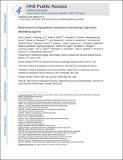Mechanisms of lymphoma clearance induced by high-dose alkylating agents
Author(s)
Lossos, Chen; Liu, Yunpeng; Kolb, Kellie E; Christie, Amanda L; van Scoyk, Alexandria; Prakadan, Sanjay M; Shigemori, Kay; Stevenson, Kristen E; Morrow, Sara; Plana, Olivia D; Fraser, Cameron; Jones, Kristen L; Liu, Huiyun; Pallasch, Christian P; Modiste, Rebecca; Nguyen, Quang-De; Craig, Jeffrey W; Morgan, Elizabeth A; Vega, Francisco; Aster, Jon C; Sarosiek, Kristopher A; Shalek, Alex K; Hemann, Michael T; Weinstock, David M; ... Show more Show less
DownloadAccepted version (1.346Mb)
Open Access Policy
Open Access Policy
Creative Commons Attribution-Noncommercial-Share Alike
Terms of use
Metadata
Show full item recordAbstract
© 2019 American Association for Cancer Research. The extraordinary activity of high-dose cyclophosphamide against some high-grade lymphomas was described nearly 60 years ago. Here we address mechanisms that mediate cyclophosphamide activity in bona fide human double-hit lymphoma. We show that antibody resistance within the bone marrow (BM) is not present upon early engraftment but develops during lymphoma progression. This resistance required a high tumor:macrophage ratio, was recapitulated in spleen by partial macrophage depletion, and was overcome by multiple, high-dose alkylating agents. Cyclophosphamide induced endoplasmic reticulum (ER) stress in BM-resident lymphoma cells in vivo that resulted in ATF4-mediated paracrine secretion of VEGFA, massive macrophage infiltration, and clearance of alemtuzumab-opsonized cells. BM macrophages isolated after cyclophosphamide treatment had increased phagocytic capacity that was reversed by VEGFA blockade or SYK inhibition. Single-cell RNA sequencing of these macrophages identified a “super-phagocytic” subset that expressed CD36/FCGR4. Together, these findings define a novel mechanism through which high-dose alkylating agents promote macrophage-dependent lymphoma clearance. SIGNIFICANCE: mAbs are effective against only a small subset of cancers. Herein, we recapitulate compartment-specific antibody resistance and define an ER stress–dependent mechanism induced by high-dose alkylating agents that promotes phagocytosis of opsonized tumor cells. This approach induces synergistic effects with mAbs and merits testing across additional tumor types.
Date issued
2019Department
Koch Institute for Integrative Cancer Research at MIT; Massachusetts Institute of Technology. Institute for Medical Engineering & Science; Massachusetts Institute of Technology. Department of Chemistry; Koch Institute for Integrative Cancer Research at MIT; Ragon Institute of MGH, MIT and HarvardJournal
Cancer Discovery
Publisher
American Association for Cancer Research (AACR)